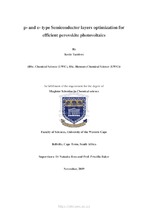| dc.contributor.advisor | Ross, Natasha | |
| dc.contributor.author | Tambwe, Kevin | |
| dc.date.accessioned | 2020-03-11T09:08:11Z | |
| dc.date.issued | 2019 | |
| dc.identifier.uri | http://hdl.handle.net/11394/7192 | |
| dc.description | >Magister Scientiae - MSc | en_US |
| dc.description.abstract | Perovskite solar cells have attracted a tremendous amount of research interest in the
scientific community recently, owing to their remarkable performance reaching up to 22%
power conversion efficiency (PCE) in merely 6 to 7 years of development. Numerous
advantages such as reduced price of raw materials, ease of fabrication and so on, have
contributed to their increased popularity. However, there are several factors that limits their
performance, among which is recombination process of charge carriers occurring at the
TiO2/Perovskite interface. Therefore, it is crucial to prevent charge carriers recombination at
the photo anode/electrode interface, in order to improve the overall efficiency of the
Perovskite solar cell (PSC) devices. | en_US |
| dc.language.iso | en | en_US |
| dc.publisher | University of the Western Cape | en_US |
| dc.subject | Semiconductors | en_US |
| dc.subject | Perovskite solar cells | en_US |
| dc.subject | Power conversion efficiency (PCE) | en_US |
| dc.title | p- and e- type Semiconductor layers optimization for efficient perovskite photovoltaics | en_US |
| dc.rights.holder | University of the Western Cape | en_US |
| dc.description.embargo | 2023-12-01 | |

